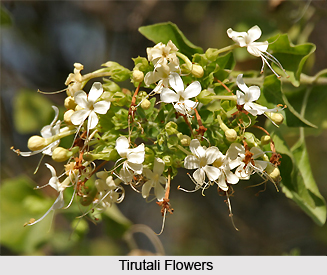 Tirutali is a small tree or sometimes a large bushy shrub commonly found in the drier regions of peninsular and northern India and is frequently cultivated as a hedge plant. The botanical name of Tirutali is Clerodendrum phlomodis. There are various other names of this medicinal plant in different languages of India. Some of them are Bataghni in Bengali, Ami, Urni and Piran in Hindi, Airanamula, Ami, Arani, Takali and Iran in Marathi, Agnimantha, Vataghni and Agni-manthah in Sanskrit, Arani, Irun, Urni and Ami in Gujarati, Hontari in Oriya, Taggi gida in Kannada, Takkolamu and Telaki in Telugu and Taludala, Thalanji and Talu-dalai in Tamil.
Tirutali is a small tree or sometimes a large bushy shrub commonly found in the drier regions of peninsular and northern India and is frequently cultivated as a hedge plant. The botanical name of Tirutali is Clerodendrum phlomodis. There are various other names of this medicinal plant in different languages of India. Some of them are Bataghni in Bengali, Ami, Urni and Piran in Hindi, Airanamula, Ami, Arani, Takali and Iran in Marathi, Agnimantha, Vataghni and Agni-manthah in Sanskrit, Arani, Irun, Urni and Ami in Gujarati, Hontari in Oriya, Taggi gida in Kannada, Takkolamu and Telaki in Telugu and Taludala, Thalanji and Talu-dalai in Tamil.
Tirutali is a large bushy shrub or small tree, with light brown bark, fissured, with dull white lenticels; branches obtusely quadrangular, more or less pubescent. The leaves of this medicinal plant of India are opposite, 1.7 to 6.8 centimetres long and 1.2 to 6 centimetres wide, ovate or subrhom-boid, margins coarsely crenate-dentate or subentire, undulate, glabrous above and more or less puberulous beneath, apex acute or short-acuminate, base truncate or subcordate; petioles slender, 0.5 to 2 centimetres long. The flowers of this shrub are fragrant, borne in small, dichotomous, axillaries, 3 to 9-flowered cymes arranged in a rounded terminal panicle; bracts obovate or lanceolate, acute, leafy; calyx c. 1 centimetre long, divided about halfway down, not enlarged in fruit, segments ovate, acutely acuminate, veined; corolla white or pinkish, tube 2 to 2.5 centimeters long, slightly pubescent outside, glabrous inside, lobes nearly equal, at least 6 millimeters long, obtuse, elliptic, veined. Fruits of this medicinal plant become black when ripe, succulent, broadly obovoid, 0.6 to 1.2 centimeters long, depressed, normally 4-lobed with 1 pyrene in each lobe. Flowers and fruits are almost seen throughout the year, depending on the locality. In the central parts of India, flowering occurs mainly between the months of October and December, and fruiting from the months of December to February.
One of the ten drugs possessing the compound Ayurvedic formulation Dasamula, the aromatic roots are regarded acrid, bitter, astringent, cardiotonic, laxative, carminative, stomachic and tonic. It is used in improving digestion and in treating constipation, fever, neurological and heart diseases, and rheumatism. A decoction of the roots is used in the Indian state of Maharashtra as a demulcent for treating gonorrhea in south India, and as a bitter tonic for children recovering from measles. The leaves of Tirutali are considered alterative, bitter and tonic; their juice is given in the treatment of Syphilis or Firanga. Among the rural and tribal inhabitants of Bhavnagar District in the state of Gujarat, the leaf juice is given as a treatment for intestinal worms, dropsy, obesity and piles. In Ayurveda, an infusion of the leaves is used to treat eruptive fevers, flatulence and colic.



















